人教版(2019)选择性必修第二册Unit 3 Food and Culture Reading and Thinking 课文解析与翻译 课件(共22张PPT)
文档属性
| 名称 | 人教版(2019)选择性必修第二册Unit 3 Food and Culture Reading and Thinking 课文解析与翻译 课件(共22张PPT) |  | |
| 格式 | pptx | ||
| 文件大小 | 19.6MB | ||
| 资源类型 | 教案 | ||
| 版本资源 | 人教版(2019) | ||
| 科目 | 英语 | ||
| 更新时间 | 2024-10-04 17:47:51 | ||
图片预览


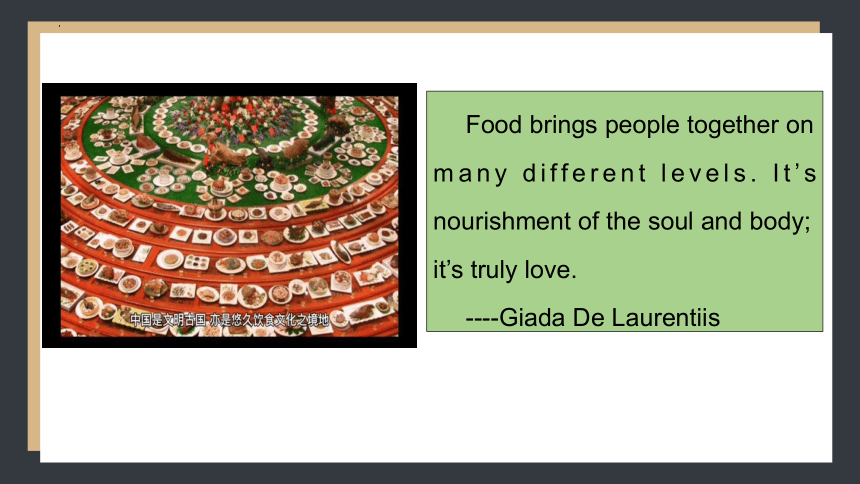
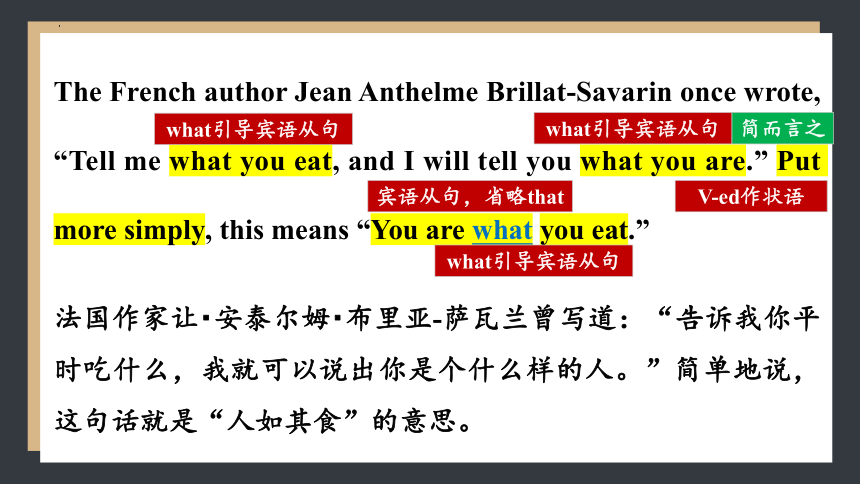
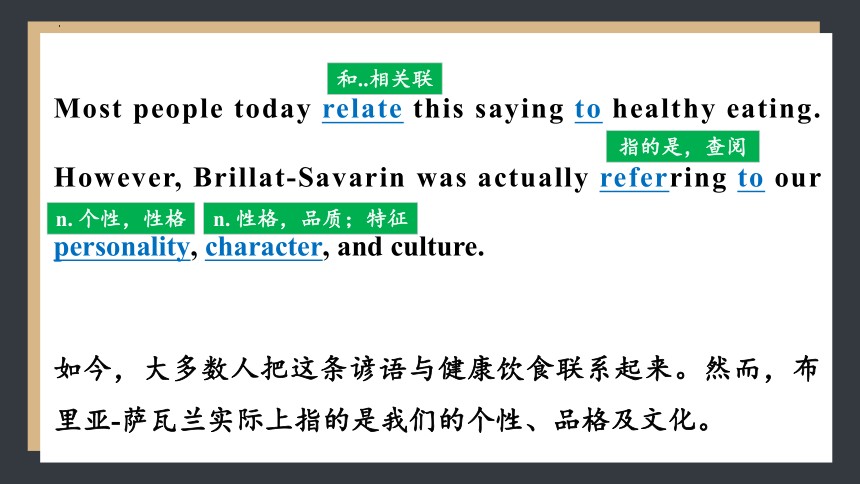
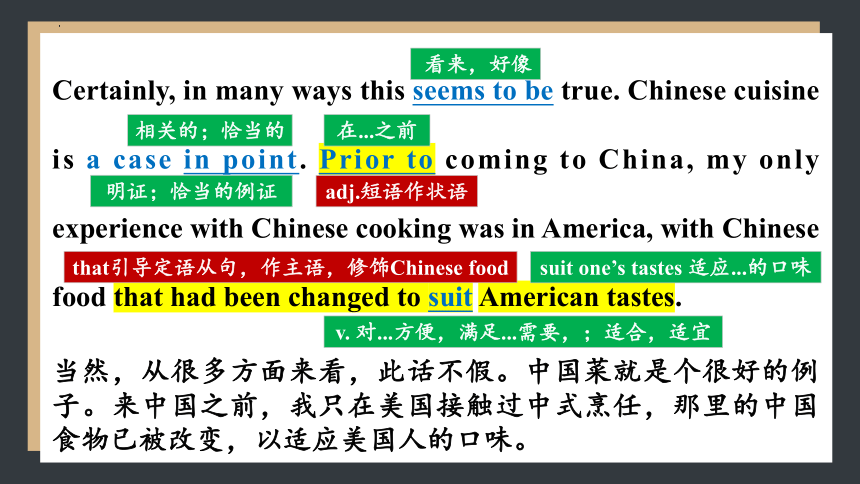
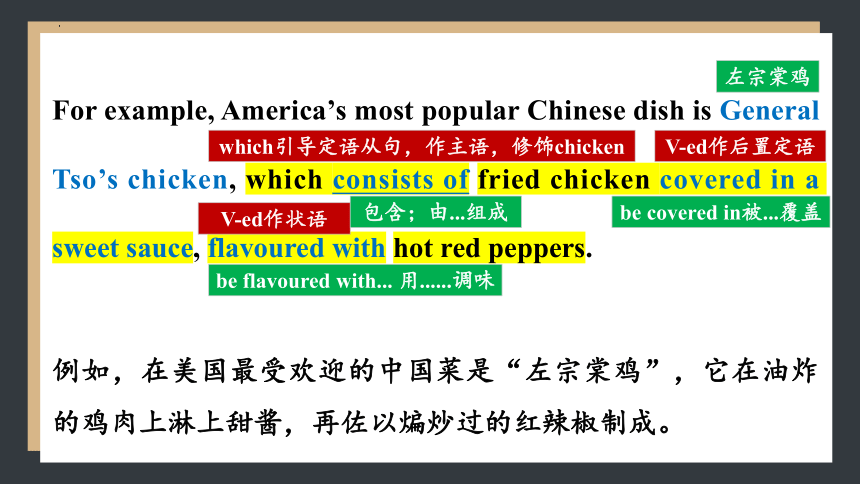
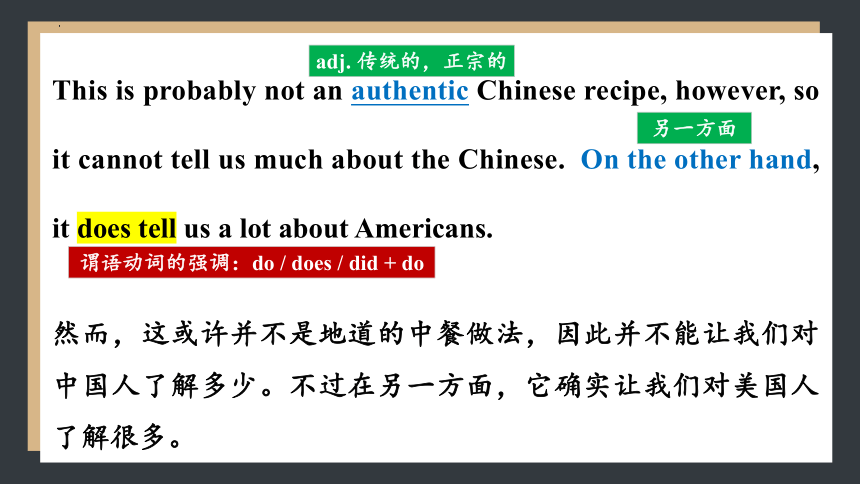
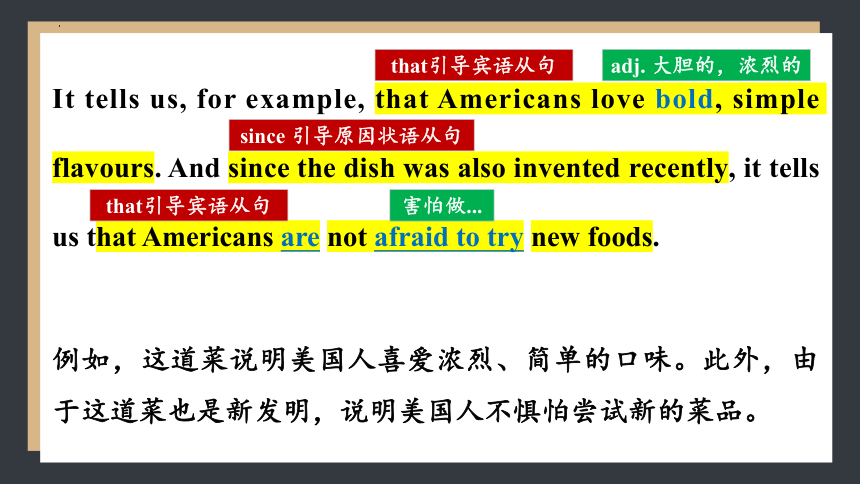
文档简介
(共22张PPT)
选择性必修一
Unit 3 Food and Culture
Reading and Thinking
第壹部分
Culture and Cuisine
文化与食物
Food brings people together on many different levels. It’s nourishment of the soul and body; it’s truly love.
----Giada De Laurentiis
The French author Jean Anthelme Brillat-Savarin once wrote, “Tell me what you eat, and I will tell you what you are.” Put more simply, this means “You are what you eat.”
法国作家让 安泰尔姆 布里亚-萨瓦兰曾写道:“告诉我你平时吃什么,我就可以说出你是个什么样的人。”简单地说,这句话就是“人如其食”的意思。
what引导宾语从句
what引导宾语从句
V-ed作状语
宾语从句,省略that
what引导宾语从句
简而言之
Most people today relate this saying to healthy eating. However, Brillat-Savarin was actually referring to our personality, character, and culture.
如今,大多数人把这条谚语与健康饮食联系起来。然而,布里亚-萨瓦兰实际上指的是我们的个性、品格及文化。
和..相关联
指的是,查阅
n. 个性,性格
n. 性格,品质;特征
Certainly, in many ways this seems to be true. Chinese cuisine is a case in point. Prior to coming to China, my only experience with Chinese cooking was in America, with Chinese food that had been changed to suit American tastes.
当然,从很多方面来看,此话不假。中国菜就是个很好的例子。来中国之前,我只在美国接触过中式烹任,那里的中国食物已被改变,以适应美国人的口味。
看来,好像
明证;恰当的例证
相关的;恰当的
在...之前
adj.短语作状语
that引导定语从句,作主语,修饰Chinese food
v. 对...方便,满足...需要,;适合,适宜
suit one’s tastes 适应...的口味
For example, America’s most popular Chinese dish is General Tso’s chicken, which consists of fried chicken covered in a sweet sauce, flavoured with hot red peppers.
例如,在美国最受欢迎的中国菜是“左宗棠鸡”,它在油炸的鸡肉上淋上甜酱,再佐以煸炒过的红辣椒制成。
左宗棠鸡
which引导定语从句,作主语,修饰chicken
V-ed作后置定语
V-ed作状语
be flavoured with... 用......调味
be covered in被...覆盖
包含;由...组成
This is probably not an authentic Chinese recipe, however, so it cannot tell us much about the Chinese. On the other hand, it does tell us a lot about Americans.
然而,这或许并不是地道的中餐做法,因此并不能让我们对中国人了解多少。不过在另一方面,它确实让我们对美国人了解很多。
adj. 传统的,正宗的
另一方面
谓语动词的强调:do / does / did + do
It tells us, for example, that Americans love bold, simple flavours. And since the dish was also invented recently, it tells us that Americans are not afraid to try new foods.
例如,这道菜说明美国人喜爱浓烈、简单的口味。此外,由于这道菜也是新发明,说明美国人不惧怕尝试新的菜品。
that引导宾语从句
that引导宾语从句
adj. 大胆的,浓烈的
since 引导原因状语从句
害怕做...
Later, I had a chance to experience authentic Chinese food by coming to China. When my family and I had just arrived in China, we went looking for a good place to eat in Beijing.
后来,我来到中国,有机会品尝地道的中国食物。我与家人刚刚抵达中国,便在北京找一个好地方吃饭。
有机会做...
方式状语
when 引导时间状语从句
去找...
to do 作后置定语
A Sichuan restaurant had been recommended to us by a friend, and finally, we found it. Tired, hungry, and not knowing a word of Chinese, we had no idea how to order, so the chef just began filling our table with the best food we had ever eaten.
一位朋友之前向我们推荐过一家川菜馆,最终我们找到了这家餐馆。我们疲惫不堪,饥肠辘辘,也不认识一个汉字,不知道该怎么点餐,所以厨师径自在我们的桌子上摆满食物;那是我们吃过的最可口的佳肴。
v. 建议,劝告 ;推荐,介绍
adj.短语 + V-ing作状语
不知道
how + to do 作同位语
V-ing作宾语
用...充满...
定语从句,省略that,修饰food
With this, we had the pleasure of experiencing an entirely new taste: Sichuan peppercorns. The food was wonderful and different, but what was even more important was the friendship offered us.
于是,我们高高兴兴地体验了种全新的口味:四川花椒。四川花椒妙不可言、与众不同,但更为重要的是我们所获得的友谊。
有…的乐趣
全新的口味
what引导主语从句
V-ed作后置定语
We soon moved to Shandong Province in the eastern part of North China. My favourite dish there was boiled dumplings served with vinegar. I observed that family is important to the people there.
不久,我们到了位于华北东部的山东省。在那里我最喜爱的食物是蘸着醋吃的水饺。我发现那里的人都很重视家庭。
在华北东部
adj. 煮沸的,煮熟的
serve ... with ... 提供...,具有...
V-ed作后置定语
that引导宾语从句
对...重要的
It has become a favourite traditional dish of the people in North China, where making dumplings has always been a family affair with everyone—from the youngest to the oldest—joining in to help.
水饺已成为华北人民最喜爱的一种传统食物,包饺子一直是一项全员参与的家庭活动,无论老少都会帮忙。
where引导定语从句,作状语,修饰North China
V-ing作主语 + 谓单
家庭活动
with的复合结构:with + 宾语 + 宾补(doing)
加入
Later, I learnt that the most famous food in Shandong is pancake rolls stuffed with sliced Chinese green onions.
后来,我了解到,最有名的山东食物是煎饼卷大葱。
that引导宾语从句
n. 薄煎饼
v. (使)翻滚,滚动;(液体)滚落,滑落;
n. 卷,卷轴;卷状食品
be stuffed with...装满......
V-ed作后置定语
adj. (食物)已切成薄片的
煎饼卷大葱
Then we moved to northern Xinjiang. Some of our friends were Kazak and Inner Mongolian.
随后,我们又到了新疆北部。我们的一些朋友是哈萨克族人和内蒙古人。
哈萨克族人
内蒙古人
These groups traditionally wandered the open range on horses. As a result, their traditional foods are what you can cook over an open fire—usually boiled or roasted meat, such as lamb kebab.
传统上,他们骑着马在广阔的草原上漫步因此,他们的传统食物在篝火上烹制而成,通常是水煮肉或烤肉,例如羊肉串。
v. 漫游,游荡,漫步
广阔的草原
因此
n. 牧场,牧区
what引导表语从句
篝火
羊肉串
Our travels then took us to South China, and then on to central China. In each place we went, we experienced wonderful local dishes, from Guangdong’s elegant dim sum -small servings of food in bamboo steamers - to the exceptional stewed noodles in Henan.
接着,我们前往华南,之后又去了华中。我们每到一处,都会品尝当地美食,有广东的精致点心-那是放在竹蒸笼里笼出来的小份食品,还有河南独特的烩面。
定语从句
华南
华中
adj. 精美的,雅致的
n.(食品等的)一份
竹子蒸笼
adj. 不寻常的,罕见的
v. 用文火慢慢煨炖;使...焦虑不安
烩面
Everywhere, the food was as varied as the people. However, one thing is always true: Through food, Chinese people everywhere show friendship and kindness.
所到之处,美食与当地人一样精彩纷呈。然而,有一件事始终不变:每个地方的中国人都通过食物展现友情与善意。
像 ...一样各式各样/种类繁多
adj. 各种各样的;多变的
At a minimum, the kinds of food local people consume tell us what they grow in their region, what kinds of lives they lead, and what they like and do not like.
当地人的食物种类至少能让我们知道该地区种植什么作物、人们过着怎样的生活以及他们的好恶。
至少
定语从句,省略that/which,修饰food
v. 消耗,消费;吃,喝
and 并列三个what引导的宾语从句
Could we also say, for example, that those who like bold flavours are bold themselves Or, that those who like spicy food tend to have a hot temper
例如,我们是否也能这样推断,喜欢重口味的人性格粗犷?抑或喜欢辛辣食物的人往往脾气火暴?
or并列两个that引导的宾语从句
who引导定语从句,作主语,修饰those
who引导定语从句,作主语,修饰those
重口味
辛辣食物
倾向于做
火暴脾气
Maybe. Maybe not. What we can say, however, is that culture and cuisine go hand in hand, and if you do not experience one, you can never really know the other.
也许是的,也许又不是。但是,我们可以确定的是,文化和美食这两者息息相关,如果你没有体验过其中的一个,你就永远无法真正了解另一个。
what引导主语从句
that引导表语从句
密切相关;共同行动
if引导条件状语从句
选择性必修一
Unit 3 Food and Culture
Reading and Thinking
第壹部分
Culture and Cuisine
文化与食物
Food brings people together on many different levels. It’s nourishment of the soul and body; it’s truly love.
----Giada De Laurentiis
The French author Jean Anthelme Brillat-Savarin once wrote, “Tell me what you eat, and I will tell you what you are.” Put more simply, this means “You are what you eat.”
法国作家让 安泰尔姆 布里亚-萨瓦兰曾写道:“告诉我你平时吃什么,我就可以说出你是个什么样的人。”简单地说,这句话就是“人如其食”的意思。
what引导宾语从句
what引导宾语从句
V-ed作状语
宾语从句,省略that
what引导宾语从句
简而言之
Most people today relate this saying to healthy eating. However, Brillat-Savarin was actually referring to our personality, character, and culture.
如今,大多数人把这条谚语与健康饮食联系起来。然而,布里亚-萨瓦兰实际上指的是我们的个性、品格及文化。
和..相关联
指的是,查阅
n. 个性,性格
n. 性格,品质;特征
Certainly, in many ways this seems to be true. Chinese cuisine is a case in point. Prior to coming to China, my only experience with Chinese cooking was in America, with Chinese food that had been changed to suit American tastes.
当然,从很多方面来看,此话不假。中国菜就是个很好的例子。来中国之前,我只在美国接触过中式烹任,那里的中国食物已被改变,以适应美国人的口味。
看来,好像
明证;恰当的例证
相关的;恰当的
在...之前
adj.短语作状语
that引导定语从句,作主语,修饰Chinese food
v. 对...方便,满足...需要,;适合,适宜
suit one’s tastes 适应...的口味
For example, America’s most popular Chinese dish is General Tso’s chicken, which consists of fried chicken covered in a sweet sauce, flavoured with hot red peppers.
例如,在美国最受欢迎的中国菜是“左宗棠鸡”,它在油炸的鸡肉上淋上甜酱,再佐以煸炒过的红辣椒制成。
左宗棠鸡
which引导定语从句,作主语,修饰chicken
V-ed作后置定语
V-ed作状语
be flavoured with... 用......调味
be covered in被...覆盖
包含;由...组成
This is probably not an authentic Chinese recipe, however, so it cannot tell us much about the Chinese. On the other hand, it does tell us a lot about Americans.
然而,这或许并不是地道的中餐做法,因此并不能让我们对中国人了解多少。不过在另一方面,它确实让我们对美国人了解很多。
adj. 传统的,正宗的
另一方面
谓语动词的强调:do / does / did + do
It tells us, for example, that Americans love bold, simple flavours. And since the dish was also invented recently, it tells us that Americans are not afraid to try new foods.
例如,这道菜说明美国人喜爱浓烈、简单的口味。此外,由于这道菜也是新发明,说明美国人不惧怕尝试新的菜品。
that引导宾语从句
that引导宾语从句
adj. 大胆的,浓烈的
since 引导原因状语从句
害怕做...
Later, I had a chance to experience authentic Chinese food by coming to China. When my family and I had just arrived in China, we went looking for a good place to eat in Beijing.
后来,我来到中国,有机会品尝地道的中国食物。我与家人刚刚抵达中国,便在北京找一个好地方吃饭。
有机会做...
方式状语
when 引导时间状语从句
去找...
to do 作后置定语
A Sichuan restaurant had been recommended to us by a friend, and finally, we found it. Tired, hungry, and not knowing a word of Chinese, we had no idea how to order, so the chef just began filling our table with the best food we had ever eaten.
一位朋友之前向我们推荐过一家川菜馆,最终我们找到了这家餐馆。我们疲惫不堪,饥肠辘辘,也不认识一个汉字,不知道该怎么点餐,所以厨师径自在我们的桌子上摆满食物;那是我们吃过的最可口的佳肴。
v. 建议,劝告 ;推荐,介绍
adj.短语 + V-ing作状语
不知道
how + to do 作同位语
V-ing作宾语
用...充满...
定语从句,省略that,修饰food
With this, we had the pleasure of experiencing an entirely new taste: Sichuan peppercorns. The food was wonderful and different, but what was even more important was the friendship offered us.
于是,我们高高兴兴地体验了种全新的口味:四川花椒。四川花椒妙不可言、与众不同,但更为重要的是我们所获得的友谊。
有…的乐趣
全新的口味
what引导主语从句
V-ed作后置定语
We soon moved to Shandong Province in the eastern part of North China. My favourite dish there was boiled dumplings served with vinegar. I observed that family is important to the people there.
不久,我们到了位于华北东部的山东省。在那里我最喜爱的食物是蘸着醋吃的水饺。我发现那里的人都很重视家庭。
在华北东部
adj. 煮沸的,煮熟的
serve ... with ... 提供...,具有...
V-ed作后置定语
that引导宾语从句
对...重要的
It has become a favourite traditional dish of the people in North China, where making dumplings has always been a family affair with everyone—from the youngest to the oldest—joining in to help.
水饺已成为华北人民最喜爱的一种传统食物,包饺子一直是一项全员参与的家庭活动,无论老少都会帮忙。
where引导定语从句,作状语,修饰North China
V-ing作主语 + 谓单
家庭活动
with的复合结构:with + 宾语 + 宾补(doing)
加入
Later, I learnt that the most famous food in Shandong is pancake rolls stuffed with sliced Chinese green onions.
后来,我了解到,最有名的山东食物是煎饼卷大葱。
that引导宾语从句
n. 薄煎饼
v. (使)翻滚,滚动;(液体)滚落,滑落;
n. 卷,卷轴;卷状食品
be stuffed with...装满......
V-ed作后置定语
adj. (食物)已切成薄片的
煎饼卷大葱
Then we moved to northern Xinjiang. Some of our friends were Kazak and Inner Mongolian.
随后,我们又到了新疆北部。我们的一些朋友是哈萨克族人和内蒙古人。
哈萨克族人
内蒙古人
These groups traditionally wandered the open range on horses. As a result, their traditional foods are what you can cook over an open fire—usually boiled or roasted meat, such as lamb kebab.
传统上,他们骑着马在广阔的草原上漫步因此,他们的传统食物在篝火上烹制而成,通常是水煮肉或烤肉,例如羊肉串。
v. 漫游,游荡,漫步
广阔的草原
因此
n. 牧场,牧区
what引导表语从句
篝火
羊肉串
Our travels then took us to South China, and then on to central China. In each place we went, we experienced wonderful local dishes, from Guangdong’s elegant dim sum -small servings of food in bamboo steamers - to the exceptional stewed noodles in Henan.
接着,我们前往华南,之后又去了华中。我们每到一处,都会品尝当地美食,有广东的精致点心-那是放在竹蒸笼里笼出来的小份食品,还有河南独特的烩面。
定语从句
华南
华中
adj. 精美的,雅致的
n.(食品等的)一份
竹子蒸笼
adj. 不寻常的,罕见的
v. 用文火慢慢煨炖;使...焦虑不安
烩面
Everywhere, the food was as varied as the people. However, one thing is always true: Through food, Chinese people everywhere show friendship and kindness.
所到之处,美食与当地人一样精彩纷呈。然而,有一件事始终不变:每个地方的中国人都通过食物展现友情与善意。
像 ...一样各式各样/种类繁多
adj. 各种各样的;多变的
At a minimum, the kinds of food local people consume tell us what they grow in their region, what kinds of lives they lead, and what they like and do not like.
当地人的食物种类至少能让我们知道该地区种植什么作物、人们过着怎样的生活以及他们的好恶。
至少
定语从句,省略that/which,修饰food
v. 消耗,消费;吃,喝
and 并列三个what引导的宾语从句
Could we also say, for example, that those who like bold flavours are bold themselves Or, that those who like spicy food tend to have a hot temper
例如,我们是否也能这样推断,喜欢重口味的人性格粗犷?抑或喜欢辛辣食物的人往往脾气火暴?
or并列两个that引导的宾语从句
who引导定语从句,作主语,修饰those
who引导定语从句,作主语,修饰those
重口味
辛辣食物
倾向于做
火暴脾气
Maybe. Maybe not. What we can say, however, is that culture and cuisine go hand in hand, and if you do not experience one, you can never really know the other.
也许是的,也许又不是。但是,我们可以确定的是,文化和美食这两者息息相关,如果你没有体验过其中的一个,你就永远无法真正了解另一个。
what引导主语从句
that引导表语从句
密切相关;共同行动
if引导条件状语从句
